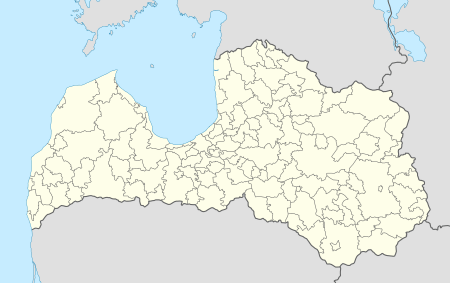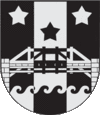Mazsalaca
| Mazsalaca | ||
|---|---|---|
| Town | ||
|
Street in Mazsalaca | ||
| ||
 Mazsalaca Location in Latvia | ||
| Coordinates: 57°52′N 25°03′E / 57.867°N 25.050°ECoordinates: 57°52′N 25°03′E / 57.867°N 25.050°E | ||
| Country |
| |
| District | Mazsalaca municipality | |
| Town rights | 1928 | |
| Population | ||
| • Total | 2,412 | |
| Time zone | EET (UTC+2) | |
| • Summer (DST) | EEST (UTC+3) | |
| Postal code | LV-4215 | |
| Calling code | +371 642 | |
| Number of city council members | 9 | |
Mazsalaca (pronounced [ˈmɑsːɑlɑtsɑ]; Livonian: Piški Salats, Estonian: Väike-Salatsi, German: Salisburg) is a town in Mazsalaca municipality, Vidzeme, Latvia with 2412 inhabitants.
Geography
The area includes the largest known Stone Age burial site in Northern Europe and was first settled ca. 5000 BC. The present town began to develop in 1864, when a bridge over the Salaca river was constructed.
In October 2009 a meteorite crater was found near the town,[1] which later turned out to be hoax as part of marketing campaign of telecommunication company Tele2.[2]
People
People who were born, lived in Mazsalaca:
- Gustavs Ērenpreiss (1891 - 1956) - bicycle master
- Augusts Kirhenšteins (1876 - 1963) - microbiologist and educator
- Valters Hirte (1913 - 1983) - craftsman
- Ansis Epners (1937 - 2003) - film director
- Oskars Perro (1918 - 2003) - soldier and writer
See also
References
- ↑ "Europe | Doubts over Latvia 'meteor crash'". BBC News. 2009-10-26. Retrieved 2012-03-15.
- ↑ Nina Kolyako, BC, Riga, 26.10.2009.Print version (2009-10-26). ""Mazsalaca meteorite" in Latvia – marketing hoax by Tele2 :: The Baltic Course | Baltic States news & analytics". The Baltic Course. Retrieved 2012-03-15.
External links
- Mazsalaca Municipality portal
 Media related to Mazsalaca at Wikimedia Commons
Media related to Mazsalaca at Wikimedia Commons
This article is issued from Wikipedia - version of the 3/19/2016. The text is available under the Creative Commons Attribution/Share Alike but additional terms may apply for the media files.
